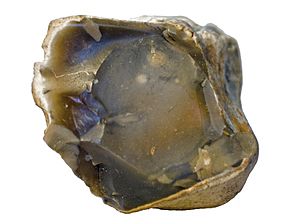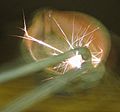Flint facts for kids


Flint, or flintstone, is a kind of sedimentary rock, made of silica.
Bands of flint are found embedded in chalk and other kinds of soft limestone.
When the chalk is eroded, the hard flint nodules survive as pebbles on a shingle beach. It may happen that the pebbles later get cemented into another rock, such as a puddingstone. In this way, they make up a sedimentary rock for the second time.
Technical description
Flint is a cryptocrystalline (means you can't see the crystals) form of the mineral quartz. It is a variety of chert. It occurs as a line of knobbly masses in chalk and some limestones. Inside the nodule, flint is usually translucent, and can be various colours. A thin layer on the outside of the nodules is usually different in colour, typically white and rough in texture.
Uses
Flintstones often have a rough lumpy surface but when they are broken, they look like dark glass. It has been one of the most useful types of stone to humankind.
Flint was used by hominins for over three million years. Stone tools found at Lake Turkana in Kenya, are dated as 3.3 million years old. This predates the genus Homo by half a million years. The oldest known Homo fossil is 2.8 million years old compared to the 3.3 million year old stone tools.
When flintstones are broken, they have a sharp edge which could be used as a knife, or a scraper. When flint and an iron-containing material such as pyrite or steel are hit together, they can make a spark. For many centuries, flint was one of the main ways for people in many countries to make fire. People would carry a little box called a "tinder box" which had some tinder along with flint and pyrite or steel. The tinder was used to catch the spark and start a fire. Tinder could be sawdust, cloth, grass or bark. Flints were later used to make a spark to fire a gun. A gun that used flint was called a "flintlock" gun.
Flintstones are used in some countries for building. In England the flintstones used for building were often "knapped" which means they were broken to show the inside, like the stones used for the tower of Long Melford Church (below). This gave a better finish to the building that the dull knobbly stones would have made.
Gallery
Related pages
Images for kids
-
Pebble beach made up of flint nodules eroded from the nearby chalk cliffs, Cape Arkona, Rügen, northeast Germany.
-
Neolithic flint axe, about 31 cm long
-
A flint church – the Parish Church of Saint Thomas, in Cricket Saint Thomas, Somerset, England. The height of the very neatly knapped flints varies between 3 and 5 inches (7.6 and 12.7 cm).
-
Close-up of the wall of the Roman shore fort at Burgh Castle, Norfolk, showing alternating courses of flint and brick
-
A typical medieval wall (with modern memorial) at Canterbury Cathedral – knapped and unknapped ("cobble") flints are mixed with pieces of brick and other stones
-
Ruins of Thetford Priory show flints and mortar through the whole depth of the wall
See also
 In Spanish: Sílex para niños
In Spanish: Sílex para niños
















